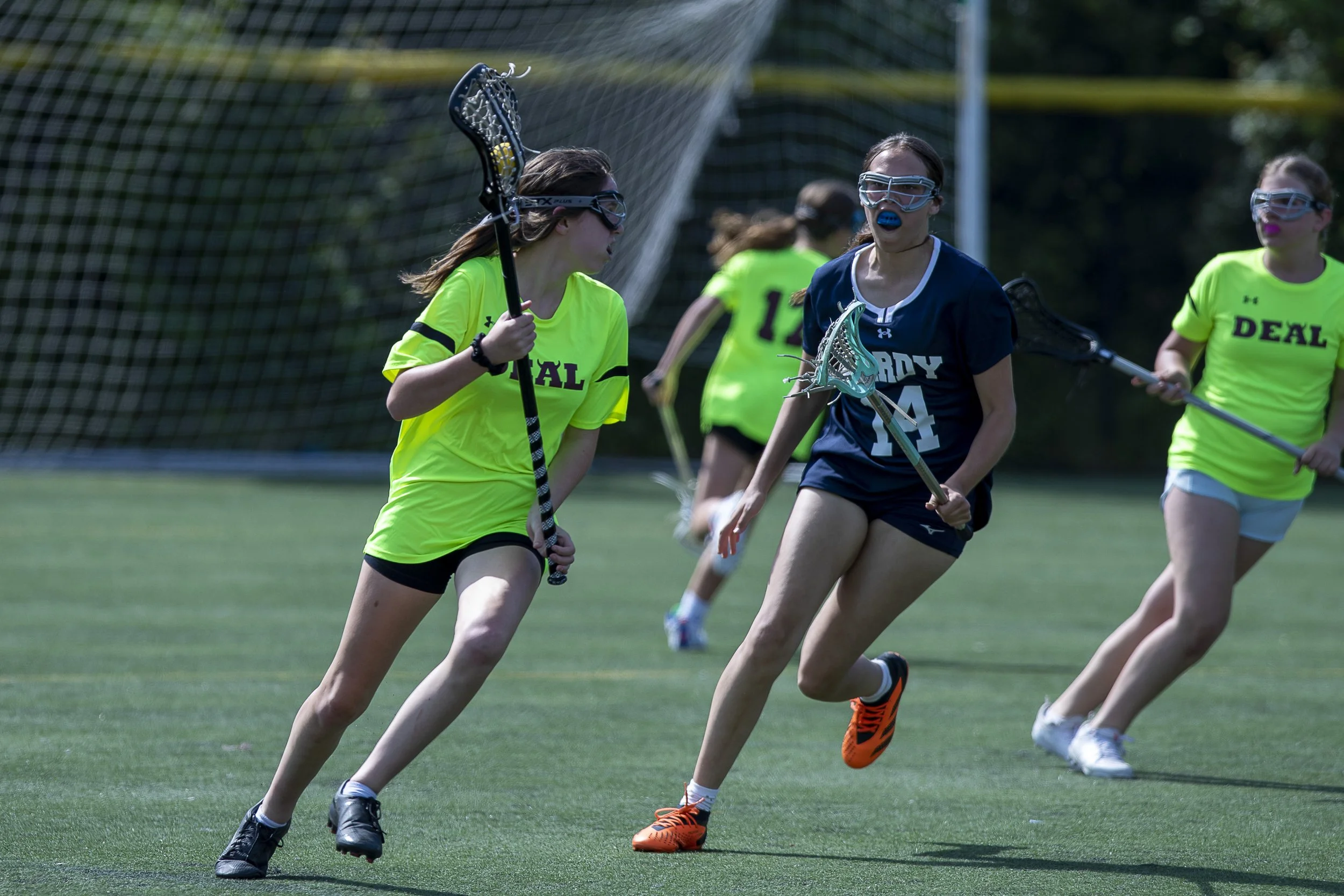Photo: DCIAA
The following article was originally published in the Aspen Institute’s State of Play Washington D.C. report. The report assesses the opportunities and barriers for more children to access sports and physical activity in our nation’s capital.
The gender gap for sports participation in D.C. is real and problematic. Only 53% of District girls participated on a sports team of any kind in 2022 and 2023, compared to 70% of boys. That’s the largest gender gap for U.S. states, according to the National Survey of Children’s Health. Our youth survey also showed that D.C. girls are less physically active than boys, according to CDC- recommended levels.
The student ratio at DCPS schools is 51% boys and 49% girls. The breakdown of DCPS sports participation by roster spots looks somewhat different, according to 2023-24 data analyzed by the Aspen Institute:
Elementary schools: boys 54%, girls 46%
Middle schools: girls 53%, boys 47%
High schools: boys 53%, girls 47%
Girls’ participation peaks in middle school and then plummets in some sports. Consider track and field, which is very popular in the District. Nationally, kids usually start it at older ages. But in D.C., girls’ participation in outdoor track declined by 43% between elementary and high school ages, while boys’ participation declined only 21%.
Girls’ basketball participation completely fell off the map between middle school and high school —a 42% decline for girls vs. a 42% increase for boys. Nationally, high school girls’ basketball has significantly declined over the past two decades for various reasons, including costs, fewer quality local programs at young ages, more girls playing volleyball, early-sport specialization and lack of interest by girls to play basketball.
Why the gap for girls in all sports? In our D.C. youth survey, boys indicated that they like playing sports in order to compete at twice the rate that girls did. Girls were slightly more likely than boys to say they like supporting their teammates and learning new skills. In focus groups we held with girls, the reasons some gave for not playing sports include:
Concern about appearance and body image
Social stereotyping and harassment
Limited role models
Perceived lack of skills
Study and work pressures
Family commitments
Costs to play
Sport programs are too focused on winning
“My friends (who are girls) want to play sports, but they’ve never played in their life before, so they have a lower skillset than other people,” said a ninth-grade girl who plays four sports. “That makes them nervous to play and the coaches add a lot of pressure.”
In our youth survey, boys indicated they were more likely to play sports in P.E. classes (56%) than girls (47%). Over several decades, girls have been impacted by decreased emphasis on quality physical education in schools, according to some P.E. teachers in the District. “There’s less education,” one P.E. teacher said. “It’s more like you go outside or go to the gym and play. There’s curriculum, but sometimes it’s almost like modified recess without enough structure. Some girls don’t want to participate in class. It’s not for them.”
An impactful development to help girls be physically active in DCPS is a district-wide program called Cornerstones, which serves boys and girls. The program teaches biking in second grade, swimming in third grade, archery in fourth grade, hiking and orienteering in sixth grade, parkour in seventh grade and rock climbing in eighth grade.
“Our goal in P.E. is to make you want to move and enjoy movement,” said Miriam Kenyon, director of DCPS P.E. and health. “We want to change our instruction to meet every kid where they are, so they have a lifelong love for movement.”
Launched in 2017, the swimming program is now in 62 D.C. elementary schools, with a focus on third grade so children learn as early as possible to stand in the shallow end of a pool. As children get older, they can take scuba diving lessons offered at four high schools and can become lifeguards.
In our youth survey, swimming was the No. 2 activity girls indicated they most regularly participate in and among the top five activities they most want to try. Girls were five times more likely than boys to say they learned to swim at school.
Bringing swimming to schools is particularly poignant for Black children given the history of segregated public pools in the District. “It’s a generational impact and our responsibility to teach kids to swim to change that negative impact,” Kenyon said. “If I’m a parent and I can’t save my child from drowning, I’m not taking them to a pool.”
The DCPS biking program through Cornerstones began in 2015. With a fleet of 1,000 bikes, DCPS teaches six lessons to second graders, culminating with a class bike ride of five to seven miles to a nearby park.
Several years ago, the development of DCPS middle school archery teams was a natural outcome of Cornerstones teaching the sport to fourth graders in P.E. class and interest growing. In 2024-25, the DCPS P.E. department began surveying students to understand what they learned in P.E. class and how they can apply it elsewhere and to other interests.
Solutions
Listen to girls about why they play or don’t play
Conduct surveys of middle school and high school students to assess their interests, abilities and attitudes about sports. Include in the survey interest levels of club and intramural sports. It’s helpful to take this a step further and use focus groups to assess girls’ intentions and goals for playing sports.
In our youth survey, girls said they were most motivated to play sports to have fun and play with friends. The top reasons why some girls don’t play sports were costs, no time due to schoolwork, no time due to other activities, and fear of injury.
Launch a campaign to distribute sports bras
As girls experience puberty, inadequate access to sports bras is a consistent cause for them dropping out of sports. A sports bra is an essential piece of athletic equipment, but one that a girl is unlikely to have if she can’t afford it or doesn’t know where to look. Sports bras that fit correctly can make a significant difference in girls playing confidently and without pain or discomfort.
According to a 2016 study published in the Journal of Adolescent Health, 46% of girls ages 11-18 years reported that their breasts had some effect on their participation in sports and exercise. This challenge was more prevalent in girls ages 13-14 (51%) and in larger-breasted girls (63%). More than half of the surveyed girls reported never wearing a sports bra during sports.
Imagine every D.C. pro sports team teaming up for a sustained District-wide effort to give out free bras while educating girls on how to find a properly fitting bra. There’s also a need for girls to receive period products in certain sports. Leveling the Playing Field, a local nonprofit that collects and donates sports equipment, partners with the Washington Spirit, DC SCORES and CVS Health to distribute bras at Spirit games and local soccer clinics.
Emphasize positive self-talk
Coaches should not pressure girls to conform to a certain body image or physique. Females are at greater risk than males for eating disorders. Coaches should avoid any reference to body weight or appearance and any comments that might suggest an athlete is overweight. Instead, coaches should connect sports and women’s health and fitness and discuss the correlation between athletic participation, women’s health risks and prevention of disease, according to the National Federation of State High School Associations.
Because boys have had a longer history of sports participation, sports providers need to be aware and sensitive to the dynamics of young female athletes who may not have had the same experiences. Coaches may need to provide precise feedback and encouragement to girls to help them develop self-confidence as opposed to screaming at, denigrating or punishing them when they make a mistake. Coaches need to understand the fear and anxiety that many young females may experience when playing sports. Coaching HER, a project of the Tucker Center for Research on Girls & Women in Sport, offers a free coaching module that challenges the status quo and the assumptions of what it means to coach girls.
Examine the community athletic programs that currently exist
High schools need quality feeder programs for girls to continue playing. Cultivate relationships with community-based athletic leagues or clubs. Reach out to younger athletes and invite them to participate in the schools’ programs in the future. Just reaching out can be impactful when a young female is uncertain whether she wants to commit to playing school sports.
Hire more female coaches and support them
Representation matters. But only 28% of youth sports coaches nationally are female, according to data from the Sports & Fitness Industry Association. A study of 20 women high school coaches found that a supportive partner who encourages them to coach and doesn’t make them feel guilty about coaching is key. For women with children, coaching may be a family activity. Children can become part of the program, extended family may pitch in, and the wider school or sport community helps with caretaking.
Build physically and emotionally safe sports programs
Abuse and harassment in sports deters girls from participating. Implementing policies to safeguard them reduces the likelihood of such offenses. The Women’s Sports Foundation has resources to help address sexual harassment and sexual relationships between coaches and other athletic personnel with athletes, and verbal, physical and psychological abuse of athletes.
Jon Solomon is Community Impact Director of the Aspen Institute’s Project Play initiative. Jon can be reached at jon.solomon@aspeninstitute.org.




